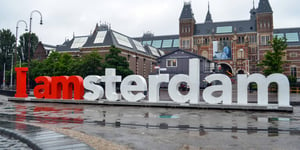This smart city portrait provides an overview of the smart city strategy and intelligent solutions implemented in the City of Amsterdam. The Dutch capital city, is one of the early adopters of smart city strategies in Europe, following their strategic smart city approach since 2008. Today, the city is one of the leading smart cities in Europe.
Amsterdam's Smart City Approach
Amsterdam, the Dutch capital city, was one of the early adopters of the smart city concept in Europe. Following a holistic strategy to become smarter that launched in 2009, it has become one of the leading smart cities in Europe and, in 2016, was named the European Capital of Innovation by the European Commission.
Holistic approaches modelled on a quadruple helix concept – government, businesses, universities & research institutions, and citizens – are key to the creation of a truly smart city. Amsterdam realized this fact early on, adopting a bottom-up methodology based on smart growth, startups, social inclusion and quality of life. The city’s approach covers all of the relevant fields of action for a municipality, which can be summarized by the indicators smart economy, smart environment, smart government, smart living, smart mobility and smart people.
The benefits of open government and open data to accelerate progress toward a smarter city are known and have also been examined by bee smart city. After taking a full inventory of the local records of more than thirty individual city departments, Amsterdam’s City Data project was born: a (mostly) open database including topographical and address data, land value and ownership information, healthcare data, traffic data and more.
But city data alone is not sufficient. Collaboration with other public and private institutions as well as the input of citizens is critical to success. The city therefore came up with the Amsterdam Smart City web platform as a primary cross-sector actor to take the city forward. To achieve strong governance, Amsterdam’s Chief Technology Officer was appointed the project leader.
Amsterdam’s Smart City Platform – Enabling Smart Collaboration
The Amsterdam Smart City online platform lies at the heart of the city’s strategic approach. An organized partnership of twelve public, private and university/research partners, it acts as a centralized forum for the communication and coordination of smart city ideas and projects: a sort of marketplace where the idea and project initiators can be matched with potential implementation partners. Those partners could be anyone – companies, start-ups, government agencies, universities, research institutions or private citizens.
In other words, the platform enables smart collaboration. Amsterdam Smart City facilitates the verification of ideas and their conversion into projects. When a project proves successful and effective during an initial small-scale test, it is extended to a larger area or upgraded in terms of functionality.
The platform groups these ideas, projects and solutions into six main project areas:
- Infrastructure & Technology
- Energy, Water & Waste
- Mobility
- Circular City
- Governance & Education
- Citizens & Living
To date, the online platform boasts a community of nearly 4000 active members, with 240 projects in various stages of development, piloting or broad implementation to continually improve Amsterdam’s livability and economic prosperity.
Amsterdam’s Smart City Solutions Ecosystem
An open and collaborative mindset coupled with favourable government regulations has facilitated an entrepreneurial spirit, which has engaged a high number of stakeholders both inside and outside of the city. Such broad engagement and strong support networks provide firm ground for the piloting of innovative ideas and projects, and have ultimately led to the formation of a whole ecosystem of smart city solutions, which is the key to bee smart city’s definition of being a ‘smart city’.
With no less than forty-seven completed products being showcased alongside the active projects on the Amsterdam Smart City Platform, other municipalities can learn a lot from Amsterdam’s smart city approach and the solutions that have been developed because of it.
Enabling Initiatives
A global first, the Internet of Things (IoT) Living Lab is a collaboration of several companies that established a network of iBeacons along a 3,400-meter stretch of the city. The beacons use an LPWA network technology, called LoRaWan, a new standard machine-to-machine protocol, to transmit small packets of data over distances of up to 3 kilometres using low-frequency radio signals. Data from the beacons is thus sent to the cloud by users, who can access it using Bluetooth-enabled devices and use it to develop new smart city apps.
Further encouraging engagement and the connection of multiple stakeholders are initiatives like StartupAmsterdam, the city’s portal connecting startups with the tools, talent and corporate backing they need to support them and strengthen Amsterdam’s economy as well as the city's startup ecosystem.
On a more individual basis, several of the projects described on the platform are aimed at kitting out Amsterdam’s citizens with the tools they need – both figurative and literal – in order to take on a more active role in the development of smart solutions for their city. Two such examples are Amsterdam Smart Citizens Lab, which seeks to engage people in scientific discussion and the monitoring of their environment, and Smart Kids Lab (part of the European Union’s Making Sense project), which helps kids leverage open-source software and hardware to build their own monitoring systems, contributing to the city’s future by equipping its children to become a central resource.
Even short-term visitors to the city are offered the chance to exercise their problem-solving skills with the gamification of complex urban challenges by Play the City, including the City Game Experience, which runs two scenarios relevant to the smart development of Amsterdam.
Social Initiatives
The freely available smartphone app Buur acts as a lower-scale platform for collaboration, encouraging a stronger sense of community by connecting neighbours and getting them to play an active role in the safety and sustainability of their neighbourhood. Have a look at this Youtube Video to learn more about it:
It provides an exchange point where citizens can ask for help with an everyday task from the people living directly around them who know how best to approach it.
A different sort of smartphone app, Urby, provides automated suggestions for local events and activities based on the location and interests of the user. With over 10,000 downloads to date, this app not only saves precious leisure time otherwise spent searching for something to do, but also indirectly promotes the businesses hosting the events and activities that more people want, and ensures that they don’t get overlooked.
Mobility Initiatives
An incredible thirty per cent of city traffic – one-third of all drivers in a city at any given time – is devoted purely to seeking a parking space. Helping people to find one faster should therefore lead to reduced noise, congestion, fuel use and city pollution levels, as well as lowering driver stress. It can also increase parking revenue while decreasing the need for manual parking control costs. With this in mind, smart traffic management is the aim of Smart Flow, an IoT cloud-based platform that manages and monitors sensors across Amsterdam to report traffic flow and parking availabilities. The pilot project for this smart parking platform led to a reduction in the average time required to find a parking spot of 43%. It also has an eye on parking costs, helping drivers to make smarter choices by revealing the cheapest options within a given area.
Another project seeking to reduce smart city traffic is Toogethr, an app that simplifies carpooling by matching passengers with potential drivers based on the location of their employment and working hours. The project’s goal is to completely remove 25,000 cars from the road altogether, leading to permanent reductions in pollution and fuel use as well as huge savings in terms of travel costs. It would also reduce the requirement for valuable city spaces to be devoted to parking. This startup received the public vote to become one of the winners of The Hague Innovators 2017 prize.
Circular City Initiatives
A circular economy strives to throw nothing away. Resources are re-used as many times as possible and then, rather than being disposed of, the component materials are recovered and regenerated, by turning them into new products. This concept derives the maximum possible value from all resources and leads to significant reductions at both ends of the traditional linear economic cycle, that is, reductions to source materials and output waste. Conversion to a circular economy also has the potential for large-scale job creation; however, in order to achieve this sort of economy, a major redesign of products and services is necessary.
The first step towards becoming a circular economy is, therefore, to identify opportunity and impact. The Circle City Scan of the City of Amsterdam did just that: it revealed the areas most likely to demonstrate significant progress toward conversion to a circular system. It examined potential drivers toward this transition as well as the effects of the necessary alterations to the city’s systems and processes. This completed study, so far the largest in the world, identified multiple waste streams that were viable for replacement with circular models. It also suggested fully developed strategies to achieve this alongside a practical roadmap for their implementation and flagged any potential barriers to success.
A separate project that is already turning one of Amsterdam’s waste streams into a useful product is Power to Protein, which takes raw proteins from sewage and uses them to generate protein powder. The process requires CO2, thereby turning a second waste product into a valuable resource. The initial phase of the project determined that up to 36% of the smart city’s population could be fed from the protein produced in just one treatment plant.

A common characteristic of Smart Cities is the ability to collaborate and co-create to make the city an even better place - Amsterdam is a great example and we are happy to welcome Amsterdam’s smart city solutions in our global smart city network“, concludes Bart Gorynski, Managing Partner at bee smart city.
ACCESS HUNDREDS OF PROVEN SMART CITY SOLUTIONS
Explore best practice smart city solutions, share your expertise and learn from the global smart city community by joining the leading global smart city network & community. Become a part of our global community and grow your network.


